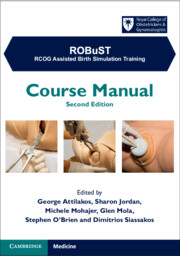Book contents
- ROBuST
- Reviews
- ROBuST
- Copyright page
- Contents
- Contributors
- Preface
- Acknowledgements
- Abbreviations
- Chapter 1 Trends in Assisted Vaginal Birth and Future Practice
- Chapter 2 Indications and Assessment for Assisted Vaginal Birth
- Chapter 3 Non-technical Skills
- Chapter 4 Vacuum-Assisted Birth
- Chapter 5 Non-Rotational forceps and Manual Rotation
- Chapter 6 Rotational Forceps
- Chapter 7 Caesarean Section at Full Cervical Dilatation
- Chapter 8 Medico-Legal Aspects of Assisted Vaginal Birth (AVB)
- Chapter 9 Analgesia and Anaesthesia for Assisted Vaginal Birth
- Index
- References
Chapter 7 - Caesarean Section at Full Cervical Dilatation
Published online by Cambridge University Press: aN Invalid Date NaN
- ROBuST
- Reviews
- ROBuST
- Copyright page
- Contents
- Contributors
- Preface
- Acknowledgements
- Abbreviations
- Chapter 1 Trends in Assisted Vaginal Birth and Future Practice
- Chapter 2 Indications and Assessment for Assisted Vaginal Birth
- Chapter 3 Non-technical Skills
- Chapter 4 Vacuum-Assisted Birth
- Chapter 5 Non-Rotational forceps and Manual Rotation
- Chapter 6 Rotational Forceps
- Chapter 7 Caesarean Section at Full Cervical Dilatation
- Chapter 8 Medico-Legal Aspects of Assisted Vaginal Birth (AVB)
- Chapter 9 Analgesia and Anaesthesia for Assisted Vaginal Birth
- Index
- References
Summary
There are currently no precise figures for the incidence of caesarean section at full dilatation, but given that there are around 200,000 caesarean births in the UK each year with around 10% at full dilatation, it potentially affects around 20,000 births per year.
- Type
- Chapter
- Information
- ROBuST: RCOG Assisted Birth Simulation TrainingCourse Manual, pp. 98 - 113Publisher: Cambridge University PressPrint publication year: 2024



